Photonic laser thruster
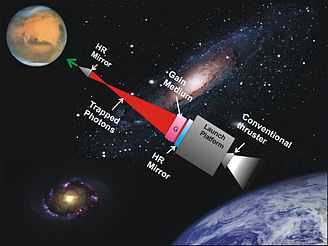
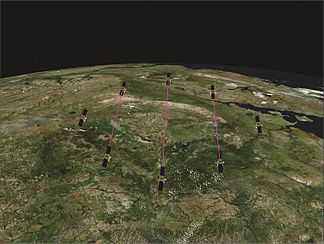
Photonic Laser Thruster (PLT)[1][2][3][4] is a pure photon laser thruster that generates amplified thrust from repetitive bouncing of photons rather than expulsion of laser heated propellant as in ablative or plasma laser propulsion. The concept of non-amplified pure photon thrusters has existed for many decades,[5] which use the momentum of photons rather than their energy and are the engines for the photon rocket. The fundamental difference between PLT and the conventional photon thruster is in that the former traps photons and let them bounce around between two high reflective mirrors installed on two spacecraft platforms while the latter expels photons. Trapping ultra-high-flux of photons requires a laser-like arrangement, where a laser amplifying medium is located between the two mirrors. By bouncing photons, PLT can amplify the thrust and overcome the inefficiencies of the conventional photon thruster, however, with some technological challenges that are predicted to be surmountable with the emerging high power laser and optics technologies.
PLT has a specific impulse (Isp: a measure of how fast the fuel can be expelled from spacecraft) orders of magnitude larger than that of other conventional thrusters, such as electrical thrusters. Thus, in principle PLT can propel spacecraft to unprecedented speeds[3] that are orders of magnitude greater than that can be achieved by the conventional rocketry, of which fuel mass exponentially increases as a function of the destination rocket speed divided by the specific impulse as in the Tsiolkovsky rocket equation.
In addition, PLT permits orders of magnitude higher accuracy in thrust angular and magnitude control than conventional thrusters including electrical thrusters and ablative laser thrusters. Such unprecedented accuracy potentially opens doors to ultra-high precision spacecraft control for formation flying, which has been extremely challenging to achieve with conventional thrusters. PLT can be used for beaming thrust from a resource vehicle to a more expensive mission vehicle,[6][7] as a tanker does in aerial refueling. Such PLT thrust-beaming is predicted to decrease significantly the cost and the complexity in remote maneuvering and stationkeeping of single or multiple satellites.
Therefore, PLT is predicted to enable wide ranges of innovative space endeavors. Low thrust (milli-Newton) PLTs enable nanometer precision spacecraft formation, for example, as in Photon Tether Formation Flight (PTFF),[8] for forming ultralarge space telescopes and radars. If PLT is successfully implemented in space and systematically scaled up, its economic interest and potential is predicted to grow exponentially. In addition, PLT is predicted to reduce the use of toxic chemicals and minimizes the pollution in near earth space environment, which is becoming a growing concern as the number of space activities rapidly increase.
By assuming that the required technologies will be developed in the future, Bae proposed a permanent energy efficient transport structure based on photon propulsion, the Photonic Railway, which aims at enabling routine interplanetary and interstellar commutes via Spacetrains.[9] The Photonic Railway, if successful, would radically depart from the conventional spaceship concepts, in which a single spacecraft carries both an engine and a large quantity of fuel. Rather, the Photonic Railway would have permanent reusable space structures that propel Spacetrains, which would consist of mainly crew habitats, and navigation and crew safety equipment. The technological foundation of the Photonic Railway lies on a strategic combination of Beamed Laser Propulsion by Forward[10][11] and PLT, which is named here PLT-BLP.[9] It is predicted that the development of PLT-BLP can be further expedited by incorporating the anticipated development in x-ray lasers and advanced material science and technologies, and the interstellar PLT-BLP is projected to be within reach in a century, if the PLT technology development rides on the Moore’s law as the 20th century silicon devices did.
Background
Photon rocket
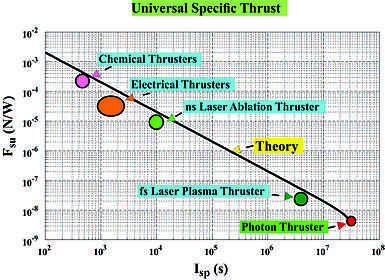
The history of Photonic Laser Thruster (PLT) begins with the photon rocket that uses direct momentum transfer of photons to propel spacecraft and has been researched since the beginning of the 20th century.[5] According to special relativity, the highest velocity of the rocket exhausts can have is the speed of light, c = 3×108 m/s. Therefore, photons are the ultimate rocket fuel that will produce the ultimate specific impulse. Photon propulsion has been widely discussed for decades[11] as a next generation propulsion that can make interstellar flight possible, which requires the ability to propel spacecraft to speeds at least 10% of the light speed, v ~ 0.1c = 30,000 km/s.
The right figure shows the thrust to power ratio, which is defined as specific thrust, of chemical rockets, electric thrusts that include Hall effect thrusters, and Pulsed Plasma Thrusters, in comparison with that of photon thrusters. The specific thrust of the photon thruster is several orders of magnitude smaller than that of conventional thruster, such as electrical thrusters, because it has the highest specific impulse, Isp. The black solid line in the figure represents a universal 1/Isp curve that shows the general behavior.[9] The inefficiency in producing thrust at extremely high Isp,which is required for interplanetary and interstellar flights, is a universal tendency (the law of physics) in all thrusters, and it is not unique to the photon thruster. In other words, if conventional thrusters can be made to have Isp~107 sec, theirs specific thrust would be similar to that of photon thrusters. Therefore, in achieving relativistic velocities, the thrust efficiency does not depend on whether the propellant is made of photons or other particles, such as protons.[9]
The universal specific thrust equation[9] thus points out that for the relativistic propulsion, particles and photons become nearly equivalent in the efficiency of generating thrust at a given propellant energy. The general trend is such that it becomes more and more technologically challenging with particles, such as protons and other ions, to generate relativistic particles. Therefore, for ultra-high Isp flights, because photons are relatively simple to generate, the photon thrusters become more advantageous. In addition, photon propulsion has other critical advantages over particle-based propulsion: the abilities of beaming and amplifying thrust with laser technologies as presented in the next section. Therefore, it makes much more sense to use photons for relativistic propulsion.[9]
One popular concept of photon rockets is a nuclear photonic rocket, which would directly produce a high flux of photons from a black body radiator heated by a nuclear reactor and expel the photons for generating significant thrust. Its disadvantage is that it takes a lot of power to generate a small amount of thrust due to its small specific thrust as in the figure, so acceleration is extremely slow. Photonic rockets are technologically feasible, but rather impractical with current technology. Regardless of the photon generator characteristics, a unified theory[9] on such onboard photon propulsion can be used for providing insight on the perspective of photon propulsion. In this unified theory, it is assumed that the propulsion system has a single stage. The approximate maximum velocities attainable by various onboard nuclear fission or nuclear fusion powered photon propulsion systems are typically on the order of 0.01% of the light velocity, which are orders of magnitude less than the required 10% of the light velocity for interstellar travel. Therefore, unless extremely complicated and heavy multistage nuclear photonic rocket engines are used, single-stage systems seem to be impractical for interstellar travel.
Beamed Laser Propulsion
The above theoretical limits posed by photon propulsion with onboard photon generators can be overcome, if the photon generators and the spacecraft are physically separated. In the Beamed Laser Propulsion (BLP) concept,[10][11] the photons are beamed from the photon source to the spacecraft using lasers. In particular, Robert L. Forward pioneered a wide range of interstellar propulsion concepts including photon propulsion and antimatter rocket propulsion.[10][11] Specifically, Forward proposed for the first time BLP aiming at the goal of achieving roundtrip manned interstellar travel. However, considering the unprecedentedly large world-scale investment required for such interstellar flight, unless there is enormous potential financial return from such endeavors, the chance of sustaining continuous return investment in such programs is dismal. Furthermore, the duration of such development could expand well over a century, and in human history, there have been only a few projects, such as the Egyptian pyramids and the Great Wall of China, which continued over such a long duration. More details on Beamed Laser Propulsion can be found in the Wikipedia articles on Laser propulsion and Beam-powered propulsion.
Recycling Photon Propulsion
The founding principle of Photonic Laser Thruster (PLT) is in the idea of recycling photons to amplify thrust. An important theoretical understanding and development of photon thrust was obtained by Marx,[12] Redding,[13] and Simmons and McInnes[14] who calculated that the energy conversion efficiency of photon propulsion is approximately proportional to v/c at low speeds (v<0.1c), thus is very small at very low speeds (v<<0.1c). However, once the spacecraft reaches higher speeds (v>0.1c), owing to the favorable Doppler-shift energy transfer, photon propulsion becomes much more energy efficient, thus there is a need to bridge this energy efficiency gap.
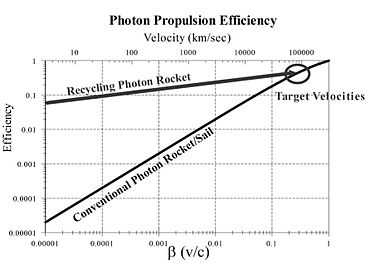
Fundamentally, photons transfer their energy to the spacecraft by redshifting due to the Doppler effect upon reflection, thus the higher the spacecraft speed is, the higher the efficiency is. The right figure schematically shows the energy transfer efficiency from the photon energy to the spacecraft kinetic energy as a function of β=v/c (the spacecraft velocity divided by the light velocity) in photon propulsion. It is interesting that as the spacecraft velocity approaches the light velocity (v ≈ c) the efficiency of photon propulsion becomes 100%, as if the spacecraft acts like a black hole in the moving direction. The lower solid curve in right figure represents the efficiency of conventional photon rocket or sail with photon recycling. The upper solid line represents schematically an example the efficiency of recycling photon rocket, PLT. At low β, the PLT can have a very high thrust amplification factor (in this example, ~3,000), however, it is expected that as β approaches 1, the PLT amplification factor should asymptotically converge to 1. Therefore, PLT is projected to bridge the above-mentioned energy efficiency gap.
Meyer et al.[15] concluded that for missions requiring very fast transit times in the solar system or for interstellar fights, the recycling photon propulsion vehicles are much more energy efficient than the onboard photon rocket, such as the nuclear photonic rocket. Possible applications of photon recycling using passive resonant optical cavities (lasers are located outside of the optical cavity), the Laser Elevator, in launching and propelling spacecraft at higher velocities with higher efficiencies than those available by exiting rocket engines, was first proposed and extensively studied by Meyer et al.[15]
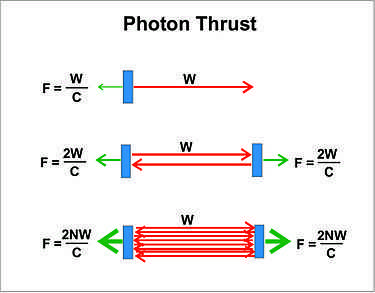
The simplest recycling scheme is a Herriot cell with multi-bouncing laser beams between two high reflectance mirrors without forming a resonant optical cavity as illustrated in the right figure. This Herriot cell type approach was first proposed by Meyer et al.[15] followed by Simmons and McInnes,[14] Their study was in depth analyzed by Mertzger and Landis.[16] This approach requires highly focused laser beam spots on each mirror to avoid the beam interference that may induce optical resonance in the cavity.
Photon thrust amplification based on the Herriot cell seems to be straightforward, however, the implementation of the concept turned out to be not. The right figure illustrates that as the cavity length and the number of photon bouncing increase in Herriot cells, the focal spot diameter projected on mirrors increases, requiring extremely large mirrors to avoid the laser beam interference.[3] Once the laser beam starts to interfere, the non-resonant cavity becomes a passive resonant cavity to be impractical for photon propulsion amplification, because of the reasons presented below.[1][2] In fact, the first experimental attempt on photon thrust amplification in a non-resonant Herriot-cell type optical cavity was performed by Gray et al.[17] They could obtained amplified photon thrust of ~0.4 µN with a 300-W laser and a photon thrust amplification factor of ~2.6, which was much smaller than the anticipated amplification factor greater than 50. The much lower-than-expected amplification factor obtained by Grey et al. revealed the above-mentioned technical difficulties in the Herriot cell concept.[3]
The passive resonant optical cavity, the resonator in Fabry-Perot interferometer, has been extensively used in high-sensitivity optical detection methods, such as the cavity ring-down spectroscopy. In the cavity ring-down spectroscopy, typically laser pulses are injected through the first mirror and bounced between two mirrors as many as tens of thousand times. The current off-the-shelf technological limit of the system reported is obtained with super mirrors used for the cavity ring down spectroscopy with the reflectance of 0.99995 with the photon bounce number of 20,000.[18] This experiment clearly demonstrated that thrust amplification in optical cavity by orders of magnitude is feasible.
However, the passive resonant optical cavity for photon thrust amplification turned out to be unsuitable for propulsion applications, because it is highly sensitive to the small changes in the distance between the mirrors and mirror deterioration. This extreme sensitivity was observed in the gravitational detection system (LIGO) with such high-Q passive optical cavities,[19] in which even one nanometer perturbation in cavity length sets the system out of resonance and nulls the photon thrust. In addition, the injection of laser power into the high-Q passive resonant optical cavity is extremely challenging because it requires near single-frequency lasers to efficiently inject the laser through the input mirror. Therefore, Bae concluded that the recycling photon propulsion based on the passive resonant optical cavity is not suitable for amplifying photon thrust, and started to look for other optical cavity design to overcome the difficulty.[1][2]
Under the auspice of NASA-NIAC,[20] Bae investigated photon recycling for the use in a nano-meter accuracy formation flight method based on photon thrusters and tethers, Photon Tether Formation Flight (PTFF),[8] with the maximum baseline distance over 10 km for the next generation NASA space missions. The usage of the passive resonant optical cavities for recycling photon propulsion described in the previous section in this article was questioned by Bae, because they are extremely unstable against the motion of the cavity mirrors, thus unsuitable for propulsion. Therefore, in 2006 Bae began to investigate the use of active resonant optical cavities, in which the optical gain medium is located within the cavity, and named the thruster with such optical cavities as the Photonic Laser Thruster (PLT).[1][2][3][4]

Initially PLT was proposed mainly to overcome the difficulties in injecting sufficient laser power in high-Q optical cavities for the usage of precision formation flying in which the mirrors of the optical cavity are in near static conditions.[8] Bae assumed that the PLT cavity would be very sensitive to the stability of the mirrors and other optical parameters. However, during the experiments, to his surprise, Bae accidentally discovered that he could sustain the PLT resonance with the mirror in his hand.[1][2] This would be impossible if the PLT cavity was highly sensitive to the cavity perturbations, such as moving and tilting. Several months’ of repeated experiments and theoretical analysis led to the conclusion that the active cavity of PLT can be made exceptionally stable against the perturbations, because the gain medium in the cavity actively compensates them by providing negative feedback to the cavity. This conclusion convinced Bae[2] that PLT would enable a range of unprecedented applications beyond PTFF.[8][20]
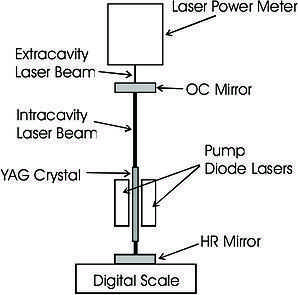
As illustrated in the right figure, in PLT, an active resonance cavity is formed between two space platforms with the laser gain media located between them, in contrast to the previously proposed multiple reflection laser photon propulsion concepts that use passive optical cavities with the laser amplification located outside of optical cavity. In December 2006, the proof-of-concept PLT was demonstrated in laboratory environment by Bae under the auspicious of NIAC/NASA.[1][2][20] The right figure illustrates the first PLT demonstration setup consisted of a concave High Reflectance (HR) mirror, a Nd:YAG Diode Pumped Solid State laser gain medium and a flat Output Coupler (OC) mirror. The photon thrust was determined by measuring the difference between the weight of the HR mirror with laser on and that with laser off with the use of a digital scale. Below is an infrared picture of the PLT in action.
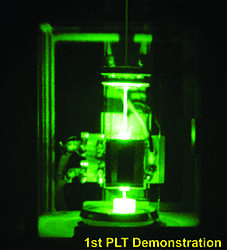
The right below figure shows the experimental results of the photon thrust measured as a function of the laser power output through the OC mirror, P, with the reflectance greater than 0.997 according to the manufacturer’s specification. The curve fitting of the data resulted in the specific thrust of 20±1 µN/W, resulting in the apparent photon momentum multiplication factor of 2,990±150 and the true OC mirror reflectance used in this demonstration of 0.99967±0.00002. The maximum photon thrust demonstrated was 35 μN. When the demonstration setup was operating at thruster levels near or beyond 35 µN, the PLT became unstable and the gain medium started to glow in yellow due to overheating. Therefore, it was realized that the thermal management issues are critical to the scaling of PLT.[1][2]

One of the factors that limit the maximum obtainable velocity of the accelerating mirror and its accommodating spacecraft is limited by the Doppler shift of the bouncing photons. Doppler shift effect on the active resonant cavity behavior is an extremely complicated issue.[1][2] Eventually, this aspect should be investigated with computer optical simulation. Optical gain in the laser cavity can only occur for a finite range of optical frequencies. The gain bandwidth is basically the width of this frequency range. For example, the gain bandwidth of the YAG laser system with the laser wavelength in the order of 1,000 nm is in the order of 0.6 nm,[21] which is ~ 0.06% of the wavelength. For an order of magnitude estimation, it can be assumed that PLT utilizing the YAG laser system will be limited by the gain bandwidth to the first order, then, theoretical maximum spacecraft velocity is ~1.8×105 m/s (180 km/s) that is 0.06% of the light velocity, c=3x108 m/s. To overcome this redshift limitation, PLT, at high operation velocities, should employ wide bandwidth lasers. Faster speeds would require further technological developments.[9]
The scalability of typical high power lasers has been extensively investigated,[22] however that of PLT needs to be investigated. The typical laser design is geared for maximizing the extracavity laser output (laser power outside the laser cavity), however, PLT is geared for maximizing the intracavity laser power (laser power inside the laser cavity).[1][2] The laser operation parameters in such an intracavity PLT-like operation has been explored to a certain degree in nonlinear harmonics generation, however, strict maximization of intracavity power (circulating power) in laser cavities is poorly understood and is a crucial issue in scaling PLT thrust.
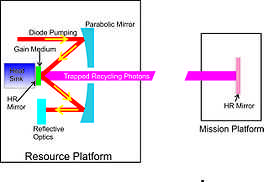
Bae and his colleagues has recently concluded that the thin disk laser (TDL) is one of the best laser systems for scaling PLT, and begun to develop a PLT based on TDL.[22] The chief advantage of the use of TDL results from that TDL operation can be optimized with high intracavity power. Typically, TDL with a 0.2 mm thick disk can be optimally operated with a 99% output coupler, which provides an intracavity power 100 times larger than extracavity power. Highly encouraged by the recent AFRL TDL demonstration[23] of the intracavity power of 800 kW that can be translated into a photon thrust of 5 mN, in 2013 Bae's group started to develop PLT with the Thin Disk Laser (TDL) technologies. A schematic diagram of the PLT system based on a TDL is shown in the right figure. A thin disk gain medium is coated with a High Reflectance (HR) with a reflectivity of up to 99.999% and attached to a heat sink. The gain medium is pumped by a diode laser beam that is reflected by reflective optics by more than 10 times to enhance power absorption with the use of a parabolic mirror. The trapped photons between the gain medium and the HR mirror located in the mission platform deliver amplified momentum beaming from the resource platform. In 2014, Bae and his colleagues has accomplished an PLT intracavity power of 154 kW with a 0.6 cm diameter thin disk laser, which can be translated into a photon thrust of 1.03 mN under the auspice of NASA-NIAC.[24]
How long the PLT cavity can be is another critical technological issue that needs to be investigated further. Traditionally, the intracavity laser arrangement required for PLT operation had been operated in relatively short cavities less than 10 m long. Therefore, there has been a concern that the action distance of PLT may not be more than tens of meters. However, Bohn[25] of the German Aerospace Center (DLR) reported that the German company Rheinmetall Defense demonstrated a 1-km long laser resonator similar to the PLT optical resonator in 1994-1995 with the use of a telescopic arrangement in the optical cavity, and that such long laser resonators can be scalable to 100 km with the usage of optics in the diameter of 70 cm. These successful demonstrations promise that PLT can be operated beyond distances in the order of 100 km. Further studies should be performed whether PLT can be used for interplanetary or interstellar distances. There are several technological challenges in increasing the cavity length, such as the required precision of optical elements, and the development beyond the present optics technologies requires to overcome the challenges.[9]
Another technological issue in implementing PLT is in the intracavity laser beam aiming, aligning, and tracking.[9] Owing to the rapid advancement in the directed energy weapon, the aiming, alignment, and tracking of laser beams on rapidly moving uncooperative targets over the distance greater than 100 km have become technologically feasible. Especially, the technology developed for long distance delivery systems, such as Air Borne Laser (ABL),[26] will play crucial role in developing PLT systems. For example, in ABL, the aiming, alignment, and tracking of the main laser rely on the scattered beam of the beacon laser (also diode pumped lasers at power level of a few kW). Similar to this, a small laser (power level of a few watts) in the mission vehicle can be used as a beacon laser.
Applications
Near Term Applications
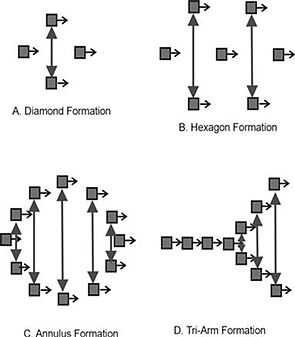
PLT-based spacecraft promises to enable innovative space missions and endeavors, and is a revolutionary departure from the “all-in-one” single-spacecraft approach, where a primary factor that dominates conventional spacecraft design is a heavy and risk-intolerant science and commercial payload.[4][6][7] Instead, PLT-based spacecraft has evolved from a different evolutionary path based on interbody dynamics via thrust beaming. This revolutionary path of PLT will enable an entirely new generation of planetary, heliospheric, and Earth-centric missions and endeavors.
Specifically, PLT can provide the unprecedented capabilities in maneuvering spacecraft in near earth orbits, thus PLT is predicted to meet the needs of the next generation of space industry by enabling a wide range of innovative space endeavors near the earth. Examples of such unprecedented capabilities include propellantless operation, thrust and power beaming for “perpetual” stationkeeping, and ultra-precision spacecraft formation flying with or without tethers.[6][8]
In addition to the straightforward spacecraft maneuvering, such as ΔV boosting in orbit via thrust beaming,[6][7] a group of spacecraft can exploit relative positions and velocities so that differential gravity provides a force opposite that of the photon thrust from PLT in a way similar to what a tether might provide. In such a scheme with two orbiting platforms in formation, their positions to the center of the mass can be controlled by adjusting the two balancing forces: 1) the photon thrust that results from the photon pressure by trapped and amplified photons in an optical cavity formed by the two spacecraft platforms, 2) the counterbalancing “virtual tug” that is generated by relative-orbital perturbation to create a revolutionary capability for maintaining persistent volumetric formations of spacecraft in earth orbit without using propellant and tethers.[4][7] Existing formation concepts are at least one of the following: not persistent, mechanically constrained (e.g. with tethers), or lie within the orbit plane, severely limiting their aperture for earth-observation missions. The PLT maneuvering system, however, could accomplish control of out-of-plane motions, thus would represent a breakthrough technology. Right figure shows examples of "virtual tug" satellite formation for forming synthetic apertures on Low Earth Orbit.
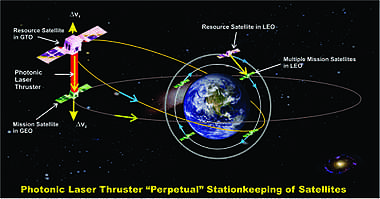
In general, only the out-of-plane force provides passive stability. However, Mason Peck proposed[27] that persistent configurations of multiple spacecraft that can be realized with active feedback that exploits nonlinearities and periodic behaviors. An exemplary innovative application of the proposed PLT spacecraft maneuvering is propellantless second-party stationkeeping, including north/south orbit maintenance for a GEO spacecraft as illustrated in the right figure. Another exemplary innovative application of the proposed PLT maneuvering system is making-up of orbit-drags with significantly reduced propellant requirement. Here, two spacecraft vehicles in very similar orbits with low inter-vehicle velocity are used for making the mission much more economical and reliable. For example, a large resource space vehicle carries low-tech items and conventional propellants and relatively small multiple mission vehicles carry high-tech and minimum conventional propellants. The replacement of such a low-tech vehicle can be very fast and economical. This situation is similar to that of the usage of airplane fuel tankers that fuel high-tech fighter jets.
Far Term Applications
The near term applications of PLT technologies are for near earth operation. A wide range of financially profitable near earth activities are envisioned to jumpstart full-scale PLT development. After near-earth PLT technologies and applications are fully developed and implemented, further successful scaling up of the PLT thrust and operation distance would enable maneuvering spacecraft and objects for interplanetary and interstellar flights.[9][10][11]
Recently, a four-phased evolutionary PLT developmental pathway towards the interstellar flight has been envisioned and proposed by Bae.[9] Each phase poses evolutionary, yet daunting, technological and financial challenges that need to be overcome within each time frame of 20 – 30 years, and is projected to generate multitudes of applications that would lead to sustainable reinvestment into its development. If successfully developed, the two-way PLT would bring about a quantum leap in the human economic and social interests in space from explorations to terraforming, mining, colonization, and permanent habitation in exoplanets.
The developmental pathway towards the interstellar flight would demand not only technological breakthroughs, but consistent long-term world-scale economic interest and investment. Such interest and investment will result from positive financial returns from routine interstellar commutes that can transport highly valuable commodities in a profitable manner. The Photonic Railway, a permanent energy-efficient transportation structure based on the Beamed-Laser Propulsion (BLP) by Forward[10][11] and the Photonic Laser Thruster (PLT)[1][2][3][4] by Bae, is proposed to enable such routine interstellar commutes via Spacetrains.[9] The envisioned Spacetrain can be built with very light materials using advanced materials and structures, and thus will have a spacious and comfortable crew environment with small and light attitude control thrusters and electronics. Another interesting aspect of the Spacetrain is that the continuous low level acceleration of 1 g will create an artificial gravity that will eliminate or minimize the health effects of weightlessness long term space travel in zero-gravity environment.[9]

Bae compared the energy need to speed spacecraft for conventional rockets and that for PLT-BLP, in terms of specific energy (J/kg) that is the energy required for propelling a unit mass to a given velocity.[9] The physics of this issue for non-relativistic cases was obtained by Meyer et al.[15] The right fiture shows examples of the specific energy (J/kg) as a function of the spacecraft velocity (km/s) relevant to Mars Photonic Railway. Two curves represent the specific energies for conventional rockets with Isp = 500 s and 3,000 s respectively. The upper straight solid line represents the specific energy for BLP and the lower straight solid line for PLT-BLP with M=1,000. It is interesting that BPL without thrust amplification becomes more energy efficient than rockets with Isp=500 s, if the travel time needs to be shorter than 1 month. BPL without thrust amplification becomes more energy efficient than rockets with Isp=3,000 s, if the travel time needs to be shorter than a week. On the other hand, PLT-BPL with a thrust amplification factor of 1,000 becomes more energy efficient than rockets with Isp=500 s, if the travel time needs to be shorter than 2 month. BPL with thrust amplification becomes more energy efficient than rockets with Isp=3,000 s, if the travel time needs to be shorter than two weeks. Eventually, when the flight time needs to be 3 days, for example, both BLP and PLT-BLP are much more energy efficient than rockets with Isp=3,000 s. This estimate clearly demonstrates Photonic Railway based on PLT-BLP is potentially the most energy efficient way to commute to planets in the solar system.
PLT-BLP was envisioned to be built on one of the Earth orbits, such as GEO, and then used for constructing PLTs either one of the Lagrange points of a planet of interest to structure an Interplanetary Photonic Railway.[9] For Mars, the solar power is still strong, thus solar pumped PLT can be operated near Mars without too much disadvantages. However, planets farther away from the sun, such as the Pluto, the solar pumping may not be efficient because of the reduced solar power at such a distance, therefore, the Photonic Railway would have two PLT-BLP systems near the Earth. The Photonic Laser Thruster offers continuous and constant thrust. This feature offers constant acceleration to the spacecraft. However, the spacecraft is still under the influence of the Sun's gravity during interplanetary traveling. In such case, the spacecraft's trajectory cannot be a straight line and traveling time may not be simply estimated. Since 2011, Fu-Yuen Hsiao has investigated the trajectories of spacecraft with PLT under the two-body problem and three-body problem assumptions.[28] Zero-velocity contours, trajectory evolution and trajectory design are investigated in Hsiao's work.
The Interplanetary Photonic Railway PLT[9] is predicted to meet the needs of the future space industry market by enabling a wide range of innovative space applications involving planets and asteroids. Some of the applications include mining and permanent habitation on other planets and asteroids. For example, once the Earth-Mars Photonic Railway is fully operated, it will play a vital role in terraforming and colonizing Mars.[10][11] Once the permanent habitation on a planet is established, the planet can be used as a space station to go to other planets or even exoplanets.
References
- ↑ 1.0 1.1 1.2 1.3 1.4 1.5 1.6 1.7 1.8 1.9 Bae, Y.K. (2007). "Photonic Laser Thruster (PLT): Experimental Prototype Development and Demonstration". AIAA Space 2007 Conference Proceedings: 2007-6156-318.
- ↑ 2.0 2.1 2.2 2.3 2.4 2.5 2.6 2.7 2.8 2.9 2.10 Bae, Y.K. (2008). "Photonic Laser Propulsion: Proof-of-Concept Demonstration". AIAA Journal of Spacecraft and Rockets 45: 153. doi:10.2514/1.32284.
- ↑ 3.0 3.1 3.2 3.3 3.4 3.5 Bae, Y.K. (2007). "Photonic Laser Propulsion (PLP):Photon Propulsion Using an Active Resonant Optical Cavity". AIAA Space 2007 Conference Proceedings: 2007-6131-818.
- ↑ 4.0 4.1 4.2 4.3 4.4 Bae, Y.K. (2007). "Photon Tether Formation Flight for Distributed and Fractionated Architectures". AIAA Space 2007 Conference Proceedings: 2007-6084-275.
- ↑ 5.0 5.1 Tsander, F. (1967). "From a Scientific Heritage". NASA TTF-541.
- ↑ 6.0 6.1 6.2 6.3 Bae, Y.K. (2012). "DE Momentum Beaming (DEMB) for Innovative Spacecraft Maneuvering" (PDF). DEPS Conference Proceedings.
- ↑ 7.0 7.1 7.2 7.3 Norman, M.C.; Peck, M.A. (2009). "Orbit Maneuvers Through Inter-Satellite Forcing". AIAA Conference proceedings: 2009-6097.
- ↑ 8.0 8.1 8.2 8.3 8.4 Bae, Y.K. (2006). "A Contamination-Free Ultrahigh Precision Formation Flying Method for Micro-, Nano, and Pico-Satellites with Nanometer Accuracy". AIP Conference Proceedings. AP813: 1213.
- ↑ 9.0 9.1 9.2 9.3 9.4 9.5 9.6 9.7 9.8 9.9 9.10 9.11 9.12 9.13 9.14 9.15 9.16 Bae, Y.K. (2012). "Prospective of photon propulsion for interstellar flight". Physics Procedia 38: 253. doi:10.1016/j.phpro.2012.08.026.
- ↑ 10.0 10.1 10.2 10.3 10.4 10.5 Forward, R.L. (1987). "Advanced Space Propulsion Study". AFRL Final Report: F04611-86-C-0039.
- ↑ 11.0 11.1 11.2 11.3 11.4 11.5 11.6 Humble, R.W.; Henry, G.N.; Larson (1995). Space Propulsion Analysis and Design. McGraw-Hill Co., New York. pp. 631–683.
- ↑ Marx, G. (1966). "Interstellar vehicle propelled by terrestrial laser beam". Nature 211: 22. doi:10.1038/211022a0.
- ↑ Redding, J.L. (1967). "Interstellar vehicle propelled by terrestrial laser beam". Nature 213: 588. doi:10.1038/213588a0.
- ↑ 14.0 14.1 Simmons, J.F.L.; McInnes, C.R. (1993). "Was Marx right? Or how efficient are laser driven interstellar spacecraft?". American Journal of Physics 61: 205. doi:10.1119/1.17291.
- ↑ 15.0 15.1 15.2 15.3 Meyer, T.R. et al. (1985). "Rapid Delivery of Small Payloads to Mars". American Astronautical Society Science and Technology Series 62: 419.
- ↑ Mertzger, R.A.; Landis, G. (2001). "Multi-Bounce Laser-Based Sails". AIP Conference Proceedings 555: 397.
- ↑ Gray, P.A. et al. (2002). "Photon Flux Amplification for Enhancing Photonic Laser Propulsive Fo". AIAA 33 rd. Plasmadynamics and Lasers Conference Proceedings.
- ↑ Romanini, D. et al. (1997). "CW Cavity Ring Down Spectroscopy". Chem. Phy. Lett 264: 316. doi:10.1016/s0009-2614(96)01351-6.
- ↑ Sheard, B.S. et al. (2004). "Observation and Characterization of an Optical Spring". Phys. Rev. A 69: 051801(R). doi:10.1103/physreva.69.051801.
- ↑ 20.0 20.1 20.2 Bae, Y.K. (2006). "A Contamination-Free Ultrahigh Precision Formation Flight Method Based on Intracavity Photon Thrusters and Tethers". NASA Institute for Advanced Concepts (NIAC).
- ↑ Yariv, A. (1975). Quantum Electronics. John Wiley & Sons.
- ↑ 22.0 22.1 Injeyan, Hagop; Goodno, G. (2011). High Power Laser Handbook. McGrow-Hill.
- ↑ Latham, W.P. et al. (2011). "6.5 kW, Yb:YAG Ceramic Thin Disk Laser". AFRL-RD-PS-TN-2011-0002.
- ↑ Bae, Y.K. (2013). "Propellantless Spacecraft Formation-Flying and Maneuvering with Photonic Laser Thruster". NASA Innovative Advanced Concepts (NIAC).
- ↑ Bohn, W.L. (2008). "Novel Aspect of Laser Propulsion". Proc. of SPIE: 7005: 70081C.
- ↑ "Boeing YAL-1". Wikipedia.
- ↑ Peck, M.A., private communication (2012).
- ↑ Hsiao, F.Y. et al. (2012). "Trajectory of spacecraft with photonic laser propulsion in the two-body problem". Acta Astronautica 84: 215. doi:10.1016/j.actaastro.2012.11.006.